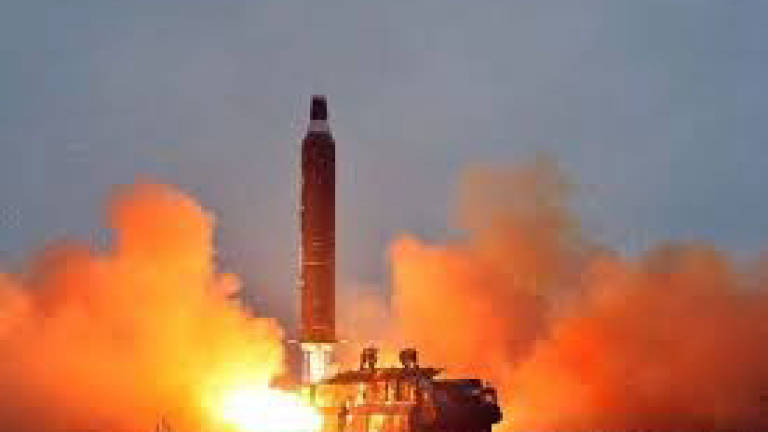Chronology of North Korean missile development

SEOUL: North Korea appeared to carry out a sixth nuclear test Sunday, with seismic monitors measuring an "explosion" of 6.3 magnitude near its main test site.
Japan's government said it confirmed a nuclear test had been carried out.
Hours earlier, Pyongyang's state media claimed that the country had developed a thermonuclear warhead that could be fitted onto its new intercontinental ballistic missile, another brazen assertion of its weapons capabilities.
The official Korean Central News Agency said leader Kim Jong-Un had inspected a miniaturised H-bomb that could be loaded onto a missile – although doubts remain over the veracity of Pyongyang's claims.
Here are key dates in the North's quest to develop a nuclear-tipped missile capable of hitting the United States:
Late 1970s: North Korea starts working on a version of the Soviet Scud-B (range 300 kilometres or 185 miles). Test-fired in 1984.
1987-92: Begins developing variant of Scud-C (range 500 km), Rodong-1 (1,300 km), Taepodong-1 (2,500 km), Musudan-1 (3,000 km) and Taepodong-2 (6,700 km).
Aug 1998: Test-fires Taepodong-1 rocket over Japan in what it calls a satellite launch – the US and others say it is a missile test.
Sept 1999: Declares moratorium on long-range missile tests amid improving ties with US.
July 12, 2000: Fifth round of US-North Korean missile talks in Kuala Lumpur ends without agreement after North demands $1 billion a year in return for halting missile exports.
March 3, 2005: Pyongyang ends moratorium on long-range missile testing, blames Bush administration's "hostile" policy.
July 5, 2006: Test-fires seven missiles, including a long-range Taepodong-2 which explodes after 40 seconds.
Oct 9, 2006: Conducts underground nuclear test, its first.
April 5, 2009: Launches long-range rocket which flies over Japan and lands in the Pacific, in what it says is an attempt to put a satellite into orbit. The United States, Japan and South Korea see it as a disguised test of a Taepodong-2.
May 25, 2009: Conducts its second underground nuclear test, several times more powerful than the first.
April 13, 2012: Launches what it has said is a long-range rocket to put a satellite into orbit, but which disintegrates soon after blast-off.
Dec 12, 2012: Launches a multi-stage rocket and successfully places an Earth observational satellite in orbit.
Feb 12, 2013: Conducts its third underground nuclear test.
Jan 6, 2016: Conducts its fourth underground nuclear test, which it says was a hydrogen bomb – a claim doubted by most experts.
March 9, 2016: Kim Jong-Un claims the North has successfully miniaturised a thermo-nuclear warhead.
April 23, 2016: Pyongyang test-fires a submarine-launched ballistic missile.
July 8, 2016: US and South Korea announce plans to deploy an advanced missile defence system – Thaad (Terminal High Altitude Area Defense).
Aug 3, 2016: North Korea fires a ballistic missile directly into Japan's maritime economic zone for the first time.
Sept 9, 2016: Conducts fifth nuclear test, its most powerful to date.
March 6, 2017: Fires four ballistic missiles in what it says is an exercise to hit US bases in Japan.
March 7, 2017: US begins deploying Thaad missile defence system in South Korea.
May 14, 2017: North Korea fires a ballistic missile which flies 700km before landing in the Sea of Japan. Analysts say it has an imputed range of 4,500km and brings Guam within reach.
July 4, 2017: Test-fires a ballistic missile that analysts say brings Alaska within reach. Pyongyang later says it was a "landmark" test of a Hwasong-14 intercontinental ballistic missile (ICBM).
July 28, 2017: Launches an ICBM with a theoretical range of 10,000 kilometres, meaning it could hit much of the United States.
Aug 26, 2017: Fires three short-range ballistic missiles.
Aug 29, 2017: Fires ballistic missile over Japan and into the Pacific, acknowledging for the first time that it has done so. South Korea says it flew around 2,700km at a maximum altitude of about 550km.
Sept 3, 2017: North Korea appears to carry out sixth nuclear test, with seismic monitors measuring an "explosion" of 6.3 magnitude near its main test site. Japan's government confirms a nuclear test has been carried out.
The apparent test comes hours after Pyongyang state media shows leader Kim Jong-Un inspecting what it professes to be an H-bomb that can be loaded onto an ICBM. The claims have not been confirmed. — AFP